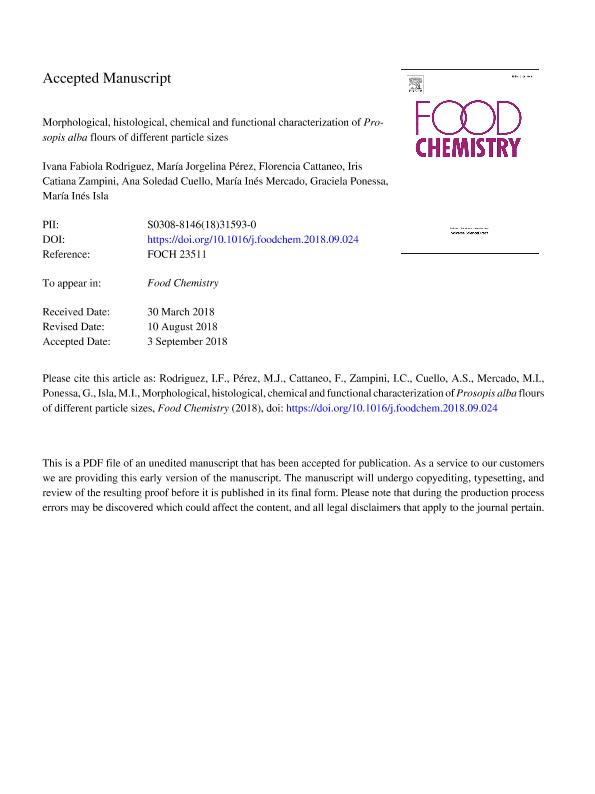Mostrar el registro sencillo del ítem
dc.contributor.author
Rodriguez, Ivana Fabiola

dc.contributor.author
Perez, Maria Jorgelina

dc.contributor.author
Cattaneo, Florencia

dc.contributor.author
Zampini, Iris Catiana

dc.contributor.author
Cuello, Ana Soledad

dc.contributor.author
Mercado, Maria Ines

dc.contributor.author
Ponessa, Graciela Ines

dc.contributor.author
Isla, María Inés
dc.date.available
2021-03-03T10:19:38Z
dc.date.issued
2019-02-03
dc.identifier.citation
Rodriguez, Ivana Fabiola; Perez, Maria Jorgelina; Cattaneo, Florencia; Zampini, Iris Catiana; Cuello, Ana Soledad; et al.; Morphological, histological, chemical and functional characterization of Prosopis alba flours of different particle sizes; Elsevier; Food Chemistry; 274; 3-2-2019; 583-591
dc.identifier.issn
0308-8146
dc.identifier.uri
http://hdl.handle.net/11336/127206
dc.description.abstract
Prosopis alba (algarrobo) flours are traditional food resources from Argentina. The aim of this work was to determine the effect of particle sizes of Prosopis flour on its chemical composition and functional properties. Flours were obtained by mechanical methods (F1 to F4, >840, 840 to 500, 500 to 149 and <149 µm, respectively). F1 and F2 contain 40% mesocarp while F3 and F4 show 80 and 90%, respectively. Mesocarp reserve parenchyma is rich in free and bound phenolic compounds, carbohydrates and fibers of the vascular system, CaCO3 crystals, and minerals (Fe, Ca, Mg, K). Apigenin C-glycosides and phenylpropanoids acids were identified in all fractions whereas F4 showed the highest level. All fractions showed functional properties. F3 and F4 showed the highest activity as H2O2 and HO• scavenger. F1 and F2 showed the highest activity as reductor agents and lipoperoxidation inhibitors. Flours with different granulometry may be suitable as functional ingredient or nutraceutical whereas flours with a smaller particle size (F3 and F4) are more interesting as functional ingredients because of their high content of bound phenolic compounds and particle homogeneity and could be used either alone or together.
dc.format
application/pdf
dc.language.iso
eng
dc.publisher
Elsevier

dc.rights
info:eu-repo/semantics/openAccess
dc.rights.uri
https://creativecommons.org/licenses/by-nc-nd/2.5/ar/
dc.subject
BOUND PHENOLICS
dc.subject
FREE PHENOLICS
dc.subject
GRANULOMETRIES
dc.subject
PERICARP FLOUR
dc.subject
PROSOPIS ALBA
dc.subject.classification
Otros Tópicos Biológicos

dc.subject.classification
Ciencias Biológicas

dc.subject.classification
CIENCIAS NATURALES Y EXACTAS

dc.title
Morphological, histological, chemical and functional characterization of Prosopis alba flours of different particle sizes
dc.type
info:eu-repo/semantics/article
dc.type
info:ar-repo/semantics/artículo
dc.type
info:eu-repo/semantics/publishedVersion
dc.date.updated
2020-11-18T17:11:42Z
dc.journal.volume
274
dc.journal.pagination
583-591
dc.journal.pais
Países Bajos

dc.journal.ciudad
Amsterdam
dc.description.fil
Fil: Rodriguez, Ivana Fabiola. Universidad Nacional de Tucumán. Instituto de Bioprospección y Fisiología Vegetal. Consejo Nacional de Investigaciones Científicas y Técnicas. Centro Científico Tecnológico Conicet Noa Sur. Instituto de Bioprospección y Fisiología Vegetal; Argentina
dc.description.fil
Fil: Perez, Maria Jorgelina. Universidad Nacional de Tucumán. Instituto de Bioprospección y Fisiología Vegetal. Consejo Nacional de Investigaciones Científicas y Técnicas. Centro Científico Tecnológico Conicet Noa Sur. Instituto de Bioprospección y Fisiología Vegetal; Argentina
dc.description.fil
Fil: Cattaneo, Florencia. Universidad Nacional de Tucumán. Instituto de Bioprospección y Fisiología Vegetal. Consejo Nacional de Investigaciones Científicas y Técnicas. Centro Científico Tecnológico Conicet Noa Sur. Instituto de Bioprospección y Fisiología Vegetal; Argentina
dc.description.fil
Fil: Zampini, Iris Catiana. Universidad Nacional de Tucumán. Instituto de Bioprospección y Fisiología Vegetal. Consejo Nacional de Investigaciones Científicas y Técnicas. Centro Científico Tecnológico Conicet Noa Sur. Instituto de Bioprospección y Fisiología Vegetal; Argentina. Universidad Nacional de Tucumán. Facultad de Ciencias Naturales e Instituto Miguel Lillo; Argentina
dc.description.fil
Fil: Cuello, Ana Soledad. Universidad Nacional de Tucumán. Instituto de Bioprospección y Fisiología Vegetal. Consejo Nacional de Investigaciones Científicas y Técnicas. Centro Científico Tecnológico Conicet Noa Sur. Instituto de Bioprospección y Fisiología Vegetal; Argentina. Universidad Nacional de Tucumán. Facultad de Ciencias Naturales e Instituto Miguel Lillo; Argentina
dc.description.fil
Fil: Mercado, Maria Ines. Consejo Nacional de Investigaciones Científicas y Técnicas. Centro Científico Tecnológico Conicet - Tucumán; Argentina. Fundación Miguel Lillo. Dirección de Botánica. Instituto de Ecología Vegetal. Área Botánica; Argentina
dc.description.fil
Fil: Ponessa, Graciela Ines. Fundación Miguel Lillo. Dirección de Botánica. Instituto de Ecología Vegetal. Área Botánica; Argentina
dc.description.fil
Fil: Isla, María Inés. Universidad Nacional de Tucumán. Instituto de Bioprospección y Fisiología Vegetal. Consejo Nacional de Investigaciones Científicas y Técnicas. Centro Científico Tecnológico Conicet Noa Sur. Instituto de Bioprospección y Fisiología Vegetal; Argentina. Universidad Nacional de Tucumán. Facultad de Ciencias Naturales e Instituto Miguel Lillo; Argentina
dc.journal.title
Food Chemistry

dc.relation.alternativeid
info:eu-repo/semantics/altIdentifier/url/https://www.sciencedirect.com/science/article/abs/pii/S0308814618315930
dc.relation.alternativeid
info:eu-repo/semantics/altIdentifier/doi/https://doi.org/10.1016/j.foodchem.2018.09.024
Archivos asociados
